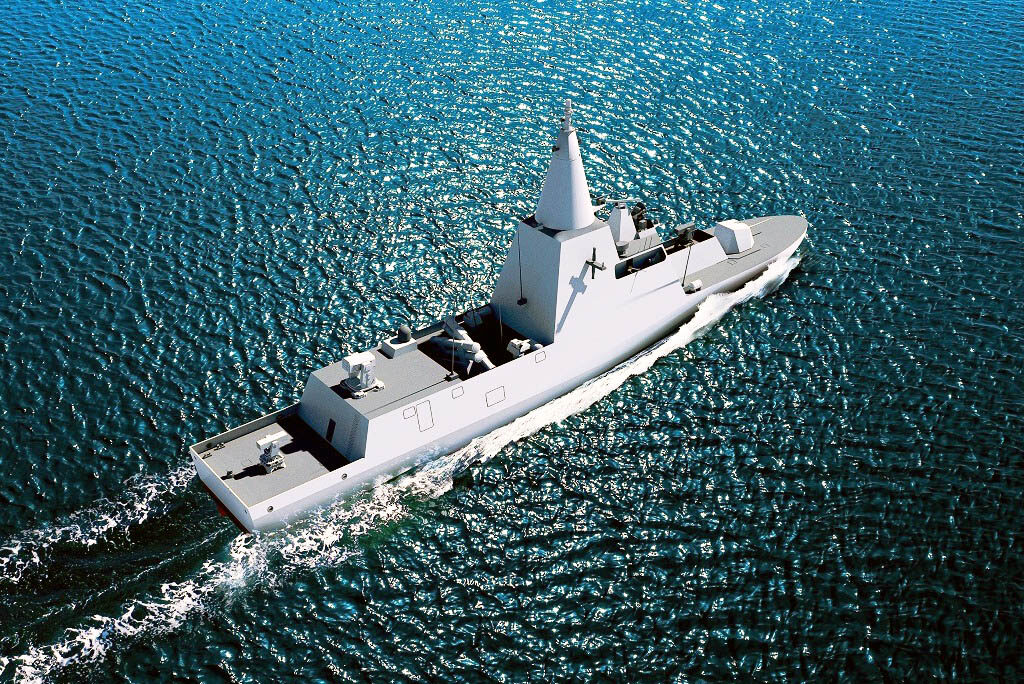
Falaj 3-class offshore patrol vessel (Courtesy of Abu Dhabi Ship Building)
BEIRUT: The United Arab Emirates is investing $982 million for four new Falaj-3 offshore patrol vessels for the Navy, in a move described as the largest order for Abu Dhabi Ship Building (ADSB), a part of the defense firm EDGE Group.
“The decision of the UAE Navy to place an order of this magnitude represents a resounding vote of confidence in ADSB and is testament to the dependability and durability of our offerings,” ADSB’s CEO David Massey told me in an exclusive interview.
The deal also reinforces the company’s commitment to developing a sustainable knowledge and innovation-based economy in line with UAE’s Vision 2030.
“We ensure that our vessels meet the most stringent end-user requirements,” he said. “We hope that this deal will lead to future orders and provide the company with new avenues of growth.”
The vessels will add unique features to the UAE Navy’s capabilities. “They will operate a highly flexible and versatile asset for maritime patrol and response duties across a wide range of missions,” Massey explained. “The Falaj-3 is designed and well-equipped to tackle the challenges of modern day asymmetric warfare in the maritime and littoral environment.”
The construction of the four vessels will take place at the company’s 300,000 square meter main shipyard in Mussafah, Abu Dhabi. They can build ships up to 80 meters in length.
“We are building all four hulls at the ADSB facility and we will also manage the integration of all systems that will then be fitted onto the vessels,” Massey told me.
Running one of the most advanced shipyards in the Middle East, ADSB operates three main naval programs: corvettes, offshore patrol vessels and fast patrol boats, while offering a full range of maintenance, repair and refit, upgrade and conversion, as well as engineering consultancy services.
Work is expected to start in the second half of 2021 with an aim to ensure the complete delivery of the project within five years.
According to Massey, each ship will be equipped with a state-of-the-art combat management system, sensors, electronic warfare and weapons systems. The vessel is also fitted with the most modern digitized integrated communication and navigation suites and features a design that reduces radar cross section, infrared, and acoustic signatures for a low profile at seas.
“While we cannot go into detail on the systems, we can confirm that they will more than match the expectations from a vessel of this sophistication – main gun, secondary armament, surface-to-surface and surface-to-air missile systems, decoys, EW and tactical communications – all controlled by a state-of-the-art combat management system,” he said.
The Falaj-3 carries a plethora of weapons, including missiles, rockets and medium-caliber guns. In addition, Falaj-3 boasts high survivability “through CBRN, fire zone, and watertight protection, and is designed with a high level of redundancy, including 100% redundancy for critical and major systems,” Massey explained.
Abu Dhabi Ship Building previously built the UAE Navy’s Baynunah-class corvettes, the last of which was delivered in 2017.
Strategically, the deal bolsters the country’s ability to combat asymmetric threats, especially ones coming from Iran, strategic expert and political researcher Abdullah Al Jenaid told me.
“The Yemeni crisis has proven the seriousness of the loopholes in securing the Yemeni coasts across the countries of the Arabian Peninsula, and the shipment of weapons that was intercepted by the guided-missile cruiser USS Monterey on May 6 is one example.”
(The US Navy stopped a ship in the North Arabian Sea carrying a large number of assault and sniper rifles, machine guns, anti-tank weapons, and even anti-tank missiles, likely bound for Iranian-backed Houthi rebels in Yemen.)
“Therefore, the operational integration of the Coast Guard and Navy represents the natural futuristic move required to counter all types of maritime threats, not only in the waters of the Arabian Gulf, but in the Arabian Sea and the Gulf of Aden,” he said. “This deal clearly shows that this shift is actually taking place.”
UK pledges ‘generational’ leap in defense spending, industry to go on ‘war footing’
Under the new plan, London wants to spend a cumulative extra of £75 billion ($93 billion) over the next six years, culminating in a 2030 annual defense budget of £87 billion ($108 billion), which would make it second in NATO only to the US in defense expenditure.


























